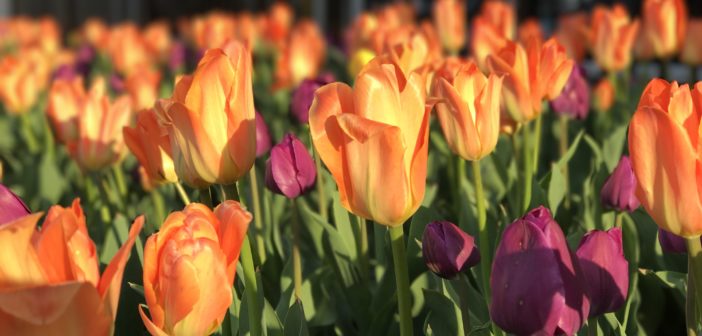Ah, springtime. Flowers bloom, trees blossom and animals awaken from their winter hibernation. The world, like the phoenix, has risen from the ashes of winter and brought new life. It is plentiful and pure — as perfect as nature is capable of becoming. What better to accompany this picture of paradise than a hypothetical pathogen capable of desecrating entire populations? I’m talking, of course, about spring fever.
We’ve all fallen victim to the infection that is spring fever. As the cold wind and dreary days fall away, a fire builds inside us. We long for the outdoors; the feeling of warm sunshine on our backs, fresh grass between our toes and the ability to wear shorts without risking hypothermia. Now there may be some winter warriors — those who prefer the cold season — but generally it seems spring tops its predecessor in popularity, and with good reason.
The first and most important contrast between the winter and spring seasons is the sun. The sun is what makes the two seasons polar opposites, what causes one to be associated with death and the other with life. Throw health into the discussion and the sun becomes vital for its role in supplying us with the essential Vitamin D. While it may be a lone one, Vitamin D is crucial for numerous functions in the body, such as immune health and bone-calcium maintenance.
Along with supplying our bodies with Vitamin D, sunlight stimulates the release of serotonin in the brain, a neurotransmitter colloquially referred to as “the happy hormone.” In the spring we also tend to be outside and active more; exercise releases dopamine, another neurotransmitter popularly known as “the feel-good hormone.” The combination of Vitamin D, sunlight and being active outdoors solidify spring’s positive effects on human health in comparison to winter, and are responsible for the contagious spring fever.
So the spring season is good for us, generally. It stimulates healthy physiological changes, which result in improved mental health, generally. We are happier during this time, generally. You may be noticing a “general” pattern occurring, and that as well is with good reason.
The acronym SAD stands for a real form of depression known as Seasonal Affective Disorder. According to the Mayo Clinic, SAD is a sub-type of major depressive disorder, so patients will often exhibit similar symptoms, including: feeling depressed, having low energy, concentration trouble and suicidal thoughts. Beyond these common symptoms there are ones specific to SAD, which itself is separated into two types: fall and winter, and spring and summer. The former is more popular and often thought of when the disorder is mentioned; it is where the “winter blues” association originates from.
A few of the fall/winter specific symptoms — weight gain, oversleeping and problems interacting socially — are relatable even for those not suffering the actual disorder. They in part are what drive our desire for springtime, and actions to oppose their effects are seen in spring. Socially there is a trend toward dieting and exercise in order to achieve the “summer body,” sleep schedules adjust to lengthening days as the calendar heads toward the summer solstice and the warm weather provides the opportunity for friends to socialize. This isn’t the case for everyone, though. Just as those suffering from the fall/winter SAD may have their symptoms alleviated, others are having theirs emerge.
There may be an initial inclination that symptoms of one type of SAD are similar to the other; how people suffer in the fall/winter are probably how they do in spring/summer. This, however, is not the case. While the shared symptoms of major depressive disorder are present in spring/summer SAD patients, they additionally experience sleep insomnia, dramatic weight loss and social anxiety. The longer days, social stigma to exercise and ability to hang with friends is not for everyone, and in some cases can prove incredibly harmful. For these people, there may not be a spring fever, but they do suffer.
Now, there’s a final, completely different association with spring fever: lethargy. Imagine this scene, probably a memory to most. You’ve just come back from spring break, there’s about 10 weeks left before school is out: what’s your mindset? One of dedication, perseverance and a desire to finish the academic year in an explosion of working hard and staying diligent? Of course not. You want to put off assignments, you “forget” to study, you find yourself daydreaming in class. The bug has bitten you — you have spring fever.
This phenomenon is more popular in the context of high school, where it has come to be known as “senioritis.” For most, the decline in motivation and increase in laziness is summed by the phrase “kids will be kids,” indicating that young generations are expected to have waning abilities to focus. It appears this phenomenon has very real consequences, as one study done by Dr. William Carpluk at the College of Saint Elizabeth found high school seniors, of two different schools and five graduating classes, saw an increase in class absence, tardiness and academic performance during their ending semester. When asked whether they thought their academic effort would decline in their final semester of high school, the majority of seniors said they thought it would. It seems this phenomenon is not only real, but also very much accepted by students. Why should it stop after senior year, especially if what follows is another four years of education, each ending in the tantalizing break of summer vacation? Thus, the cycle of spring fever lives on.
It appears this phenomenon has very real consequences, as one study done by Dr. William Carpluk at the College of Saint Elizabeth found high school seniors, of two different schools and five graduating classes, saw an increase in class absence, tardiness and academic performance during their ending semester. When asked whether they thought their academic effort would decline in their final semester of high school, the majority of seniors said they thought it would. It seems this phenomenon is not only real, but also very much accepted by students. Why should it stop after senior year, especially if what follows is another four years of education, each ending in the tantalizing break of summer vacation? Thus, the cycle of spring fever lives on.
Whether we find ourselves basking in the sun to stimulate hormone release, ailed by a plethora of symptoms from SAD, or using the approaching summer vacation to act lazy, there’s no question the arrival of the spring season has real consequences. While there is no actual “spring fever” in medical terms, there are several connotations of the phrase, with positive and negative associations, that validate its use. So when those flowers bloom, trees bud and the sun shines strong, get ready: in one or another, spring fever is on its way.


